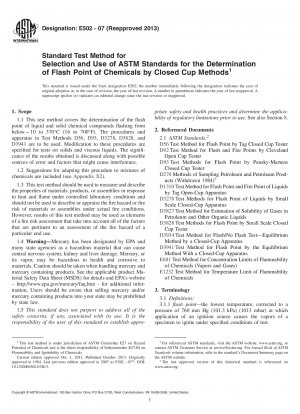ASTM E502-07(2013)
Standard Test Method for Selection and Use of ASTM Standards for the Determination of Flash Point of Chemicals by Closed Cup Methods
- Standard No.
- ASTM E502-07(2013)
- Release Date
- 2007
- Published By
- American Society for Testing and Materials (ASTM)
- Status
- Replace By
- ASTM E502-21
- Latest
- ASTM E502-21a
- Scope
5.1 The flash point measures the response of the sample to heat and flame under controlled laboratory conditions. It is only one of a number of properties that must be considered in assessing the overall flammability hazard of a material.
5.2 As a result of physical factors inherent in the apparatus and procedure, the closed cup flash point does not necessarily represent the minimum temperature at which a material can evolve flammable vapors, and the absence of a flash point does not guarantee nonflammability (see Appendix X1 and Appendix X2).
5.3 Flash point is used in shipping and safety regulations to define flammable and combustible materials. Test Methods D56, D93, and D3278 are specified as test methods for determining the flash point of these materials.
5.4 If the process or handling conditions dictate the usage of a flammable material at temperatures ranging upward from 5 to 10°C below the closed-cup flash point, then a flammable vapor might be present above the liquid. In such cases, it may be more appropriate to use the temperature limit of flammability (as determined by Test Method E1232) instead of flash point.
5.5 Small scale methods involving equilibrium procedures and only one flame pass per specimen are preferred.
1.1 This test method covers the determination of the flash point of liquid and solid chemical compounds flashing from below8201;−8201;10 to 370°C (16 to 700°F). The procedures and apparatus in Test Methods D56, D93, D3278, D3828, and D3941 are to be used. Modification to these procedures are specified for tests on solids and viscous liquids. The significance of the results obtained is discussed along with possible sources of error and factors that might cause interference.
1.2 Suggestions for adapting this procedure to mixtures of chemicals are included (see Appendix X2).
1.3 This test method should be used to measure and describe the properties of materials, products, or assemblies in response to heat and flame under controlled laboratory conditions and should not be used to describe or appraise the fire hazard or fire risk of materials or assemblies under actual fire conditions. However, results of this test method may be used as elements of a fire risk assessment that take into account all of the factors that are pertinent to an assessment of the fire hazard of a particular end use.
1.4 Warning—Mercury has been designated by EPA and many state agencies as a hazardous material that can cause central nervous system, kidney and liver damage. Mercury, or its vapor, may be hazardous to health and corrosive to materials. Caution should be taken when handling mercury and mercury containing products. See the applicable product Material Safety Data Sheet (MSDS) for details and EPA’s website – http://www.epa.gov/mercury/faq.htm - for additional information. Users should be aware that selling mercury and/or mercury containing products into your state may be prohibited by state law.
1.5 This standard does not purport to address all of the safety concerns, if any, associated with its use. It is the responsibility of the user of this standard to establish appropriate safet......
ASTM E502-07(2013) Referenced Document
- ASTM D1310 Standard Test Method for Flash Point and Fire Point of Liquids by Tag Open-Cup Apparatus
- ASTM D270 Standard test method for water and sediment in distillate fuels from centrifuges
- ASTM D3278 Standard Test Methods for Flash Point of Liquids by Small Scale Closed-Cup Apparatus
- ASTM D3827 Standard Test Method for Estimation of Solubility of Gases in Petroleum and Other Organic Liquids
- ASTM D3828 Standard Test Methods for Flash Point by Small Scale Closed Tester
- ASTM D3934 Standard Test Method for Flash/No Flash Test-Equilibrium Method by a Closed-Cup Apparatus
- ASTM D3941 Standard Test Method for Flash Point by the Equilibrium Method With a Closed-Cup Apparatus
- ASTM D56 Standard Test Method for Flash Point by Tag Closed Tester
- ASTM D92 Standard Test Method for Flash and Fire Points by Cleveland Open Cup
- ASTM D93 Standard Test Methods for Flash-Point by Pensky-Martens Closed Cup Tester
- ASTM E1232 Standard Test Method for Temperature Limit of Flammability of Chemicals
- ASTM E681 Standard Test Method for Concentration Limits of Flammability of Chemicals (Vapors and Gases)
ASTM E502-07(2013) history
- 2021 ASTM E502-21a Standard Test Method for Selection and Use of ASTM Standards for the Determination of Flash Point of Chemicals by Closed Cup Methods
- 2021 ASTM E502-21 Standard Test Method for Selection and Use of ASTM Standards for the Determination of Flash Point of Chemicals by Closed Cup Methods
- 2007 ASTM E502-07(2013) Standard Test Method for Selection and Use of ASTM Standards for the Determination of Flash Point of Chemicals by Closed Cup Methods
- 2007 ASTM E502-07e1 Standard Test Method for Selection and Use of ASTM Standards for the Determination of Flash Point of Chemicals by Closed Cup Methods
- 2007 ASTM E502-07 Standard Test Method for Selection and Use of ASTM Standards for the Determination of Flash Point of Chemicals by Closed Cup Methods
- 2006 ASTM E502-06a Standard Test Method for Selection and Use of ASTM Standards for the Determination of Flash Point of Chemicals by Closed Cup Methods
- 2006 ASTM E502-06 Standard Test Method for Selection and Use of ASTM Standards for the Determination of Flash Point of Chemicals by Closed Cup Methods
- 1984 ASTM E502-84(2000) Standard Test Method for Selection and Use of ASTM Standards for the Determination of Flash Point of Chemicals by Closed Cup Methods
- 2000 ASTM E502-84(1994) Standard Test Method for Selection and Use of ASTM Standards for the Determination of Flash Point of Chemicals by Closed Cup Methods

Copyright ©2024 All Rights Reserved